Raving Rabid Ratlets
No, I am not referring to the Rabbid's and their plungers – ratlets have far more interesting things to do, they're known for being smart after all!
[Disclaimer: please note the rat in this video can be rather "speshal" at times and her cage-mates are perfectly capable of climbing on this without utter fail and would not like their reputations to be tarnished by this evidence *g*]
In this article I'll be giving a general overview of a somewhat underrated animal with a less than positive stereotype - the rat. Actually, as I'll be talking about pet rats, I'll be referring specifically to the species known as Rattus Norvegicus, or the brown rat. In spite of the name, there is no clear link between this species and Norway! The other member of the Rattus genus that is found more or less worldwide is the black rat, Rattus rattus, but they are much less common as pets.
Rats in History
Rats are often perceived as dirty, disease-ridden vermin. This stereotype seems to be something we are more or less brought up with - I have heard children in petshops asking "Dad, are rats poisonous?" and responses of "No, you don't want a rat, they'll make you ill." Indeed, a number of people can't for the life of them fathom why I chose to own rats as pets. The original basis for the stereotype seems to lead back to the Black Death in the middle of the 14th century, in which on average 30-45% of the population died in affected areas - in some locations this percentage was higher.[1] The most common explanation for the Black Death is the spread of the bubonic plague (caused by the Yersinia pestis bacteria). DNA evidence of Yersinia pestis at suspected plague sites supports this theory.[2] The bubonic plague is postulated to have been transported around Europe on merchant ships by the rats.
Now with a death toll this high, perhaps the current day attitude towards rats is unsurprising, however the above story does not contain all of the facts. It was not actually the rats that infected anyone, it was fleas. The rats maybe have carried the fleas (Xenopsylla cheopis) but it was a flea bite that infected someone. Regardless, the rats involved in this case were Rattus rattus - not the brown rat. The two are entirely different species and cannot interbreed. I'm not saying that rats in the wild cannot breed incredibly fast and often be a pest to people in both rural and city locations, however domesticated rats are not really the same thing.
Domestication of Rats
Domesticated rats are often referred to as "Fancy Rats" - the word fancy simply indicating that the rats are "desired." Whilst evidence suggests dogs have been domesticated for 15,000 years or more and horses for 5,000 or more, rodents were domesticated much more recently - predominantly as before this the concept of a "pet" did not exist.[3] In fact, the term "pet" did not exist outside of Scotland/Northern England until the 18th century, and was originally used to refer to a spoiled child.[4] Gerbils have only really existed as pets since the 1960s, hamsters since the 1930s - rats have been kept as pets since the 1840s-1860s.[3,5,6] The domestication of rats came about due to their use in blood sport (the "rat pits"), but by 1912 the interest in rats in Britain was sufficient that the National Rat and Mouse Club was formed. Interest in the rat fancy has always been somewhat diminished by their unsavoury reputation, however since 1976, the National Fancy Rat Society has flourished within the UK.[6,7] Now rats are commonly available in pet stores and from back-yard breeders as well as from more responsible, ethical sources.
General Facts
Disease: You are ridiculously unlikely to catch any disease from a pet rat. They've been domesticated for over 150 years and with an average life-span of around 2 years, have been through a number of generations by now. Rats are also indoor pets - you're far more likely to pick something up from a cat or dog. A reported case of a women getting Weil's disease (leptospirosis) from a pet rat in 2008 actually occurred because she adopted a wild rat, not a domesticated one.[8]
Behaviour: Rats are incredibly sociable creatures - in the wild they live in large groups with a clear hierarchy (an alpha in charge, a beta as second etc). As pets they often choose to sleep together in a hammock, will regularly groom each other (and themselves) and engage in play - chasing, tumbling and pinning each other. In spite of what some people may say, male rats can live together - I know of people who've had over 12 living happily in one group; male rats are more likely than females to potentially be aggressive to their cagemates due to a hormonal surge at puberty however.
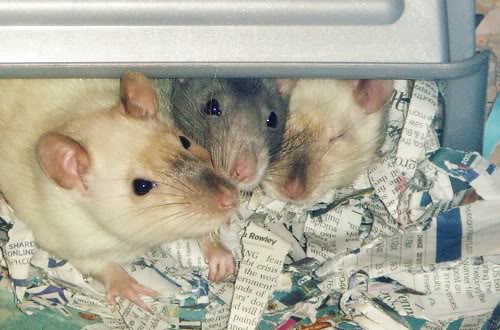
Cleanliness: In spite of their reputation rats are extremely clean animals to keep as pets. They can be litter trained and spend an awful lot of time grooming themselves and their cagemates. As a whole they don't tend to require any bathing to keep them clean.
Habitat: As they love climbing and can have delicate respiratory systems, wire cages with a deep base (to allow digging in substrate) are recommended. Rats love burrowing, tunnels, climbing, leaping between ledges and some enjoy using wheels. It has to be said however that activities are always considered much more fun if food is involved!
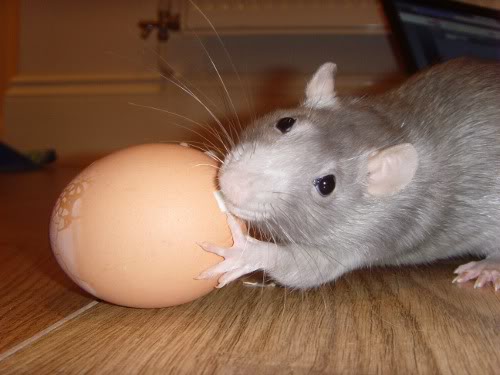 Personality: Before owning rats, I'd read about their amazing and distinct personalities but did not fully understand it until I'd witnessed it. They definitely have character! They are highly inquisitive animals and seem to have a somewhat determined/stubborn streak becoming more fixated on something if they know they aren't meant to do it (like kids!) Their climbing ability combined with the capability to jump 2ft6 (75cm) or more vertically means they can get themselves into all sorts of trouble - especially as they really aren't so good at getting back down!
Personality: Before owning rats, I'd read about their amazing and distinct personalities but did not fully understand it until I'd witnessed it. They definitely have character! They are highly inquisitive animals and seem to have a somewhat determined/stubborn streak becoming more fixated on something if they know they aren't meant to do it (like kids!) Their climbing ability combined with the capability to jump 2ft6 (75cm) or more vertically means they can get themselves into all sorts of trouble - especially as they really aren't so good at getting back down!
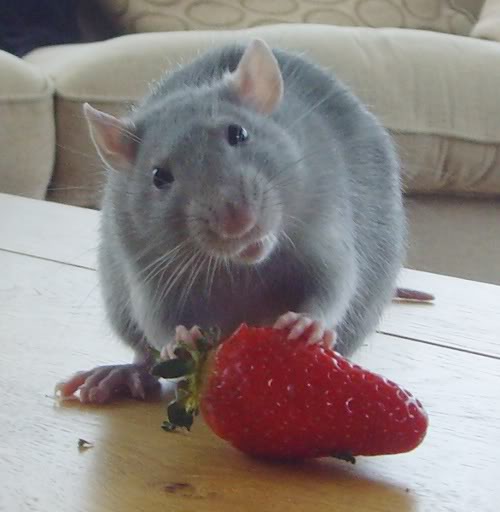 Reproduction: Part of the reason rats are seen as a pest in the wild is due to this! Females can become pregnant from around 4-5 weeks of age (typically) and the gestation period is only 21-23 days. Litters of around 12-14 are not uncommon. As such, as pets, they should clearly never live in same-sex groups unless neutered!
Reproduction: Part of the reason rats are seen as a pest in the wild is due to this! Females can become pregnant from around 4-5 weeks of age (typically) and the gestation period is only 21-23 days. Litters of around 12-14 are not uncommon. As such, as pets, they should clearly never live in same-sex groups unless neutered!
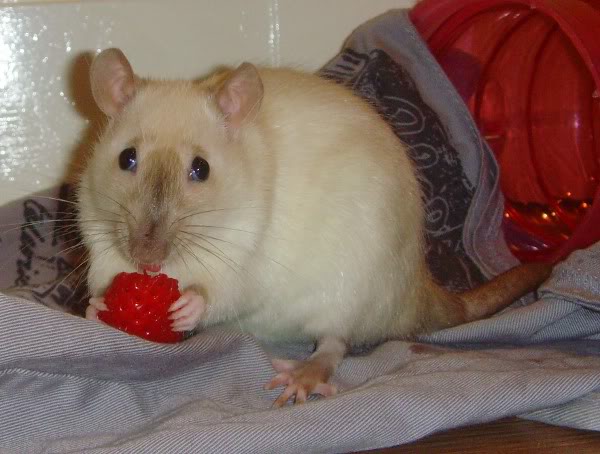 Tails: Probably the most commonly stated thing that people don't like about rats is their tails, which is fair enough - no more illogical than the general "ARGH SPIDER" reaction so many people have. Rats actually use their tails an awful lot however to help them with their balance - it's part of what makes able to do their agile acrobatics! As an effectively "fur-free" area, tails are also used to help regulate body temperature to prevent overheating. In general rats are much more capable of dealing with the cold than with heat.
Tails: Probably the most commonly stated thing that people don't like about rats is their tails, which is fair enough - no more illogical than the general "ARGH SPIDER" reaction so many people have. Rats actually use their tails an awful lot however to help them with their balance - it's part of what makes able to do their agile acrobatics! As an effectively "fur-free" area, tails are also used to help regulate body temperature to prevent overheating. In general rats are much more capable of dealing with the cold than with heat.
Varieties: Whilst they are descended from the wild brown rat, fancy rats come in a range of colours and are rarely just brown (agouti). Coat colours range from black to white, with all sorts of orange-y, grey and creamy shades in between with a range of markings also seen. Eyes can be pink, ruby (of varying shades) and black.
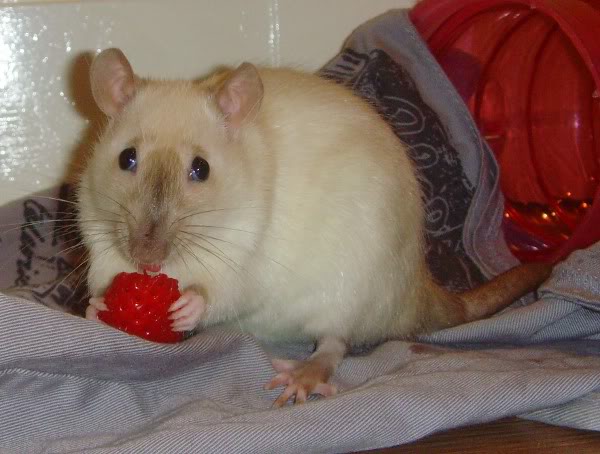 Vocalisations: In general rats are very quiet creatures - at least within the range of human hearing. Rats can communicate using ultrasonic (high frequency) noises that can actually be picked up with bat detectors! This ultrasonic chirping has been detected when rats are greeting their owner, enjoying being tickled or playing. One audible noise produced by rats is known as bruxing, where the rats grind their teeth together. Although this can be a sign of stress, it is most commonly a sign of contentment. When they get extremely into it this can also lead to "boggling" where their eyes move in and out as the muscles involved in teeth grinding are located in the eye socket.[9] Yes, this does look extremely weird and disconcerting until you're used to it!
Vocalisations: In general rats are very quiet creatures - at least within the range of human hearing. Rats can communicate using ultrasonic (high frequency) noises that can actually be picked up with bat detectors! This ultrasonic chirping has been detected when rats are greeting their owner, enjoying being tickled or playing. One audible noise produced by rats is known as bruxing, where the rats grind their teeth together. Although this can be a sign of stress, it is most commonly a sign of contentment. When they get extremely into it this can also lead to "boggling" where their eyes move in and out as the muscles involved in teeth grinding are located in the eye socket.[9] Yes, this does look extremely weird and disconcerting until you're used to it!
Vocabulary: Male rats are called bucks, females are does and baby rats are known as kittens.
Whether you are or aren't a rat fan, hopefully this article has at least taught you something new about Rattus norvegicus and helped you understand a little more about this somewhat misunderstood creatures.
References
[1] http://www.bbc.co.uk/history/british/middle_ages/black_01.shtml
[2] http://mic.sgmjournals.org/content/150/2/263.full
[3] http://www.historyworld.net/wrldhis/PlainTextHistories.asp?historyid=ab57
[4] http://www.etymonline.com/index.php?term=pet
[5] http://www.gerbils.co.uk/gerbils/ngsinfo.htm
[6] http://www.afrma.org/rminfo4a.htm
[7] http://www.nfrs.org/
[8] http://www.cabdirect.org/abstracts/20093033858.html;jsessionid=8281743EF9EAC55BFFA98F3347662542
[9] http://www.fancy-rats.co.uk/information/guides.php?subject=interpreting






